Property: natural and imprescriptible human right, foundation of freedom, engine of wealth, maker of peace and law. The concept that runs through western democracy like steel through reinforced concrete, which wrote the code for the formation of the United States and underwrote the expansion of great cities, which has been embraced by developing economies as the means to prosperity and private fulfilment, and without which neither industrial nor post-industrial society, nor uncountable cultural, social and economic benefits that follow, would exist.
A good craved by individuals that converts personal effort into permanent achievement. A foundation for a good home, for the shelter and setting of your life and the repository of your dreams. Property, which also has a way of making the world go mad.
Property ownership promises to make you rich, happy and free, yet over and over that promise is kept at the expense of others
I have lived, my whole adult life, through the project known as the property-owning democracy. It was based on the idea that property would make you a better, happier and richer person and responded to the simple, reasonable and powerful desire of very many people to own their home. The property-owning democracy would set you free. For Margaret Thatcher, for whom it was a defining and prodigiously successful concept, it was a “crusade to enfranchise the many in the economic life of the nation”.
So she sold off council houses to their tenants and deregulated and liberalised mortgage markets. From 1980 to 1990 rates of home ownership rose from 55% to 67% of households. At the same time prices rose, almost trebling during her 11-year term. In general Thatcher’s government prided itself on fighting inflation, inflicting heavy costs on employment in an attempt to bring the annual rate down. But with property it was different. Inflation, when it came to homes, was to be celebrated. It was seen as a sign of economic virility, and it made those who had bought feel good. Succeeding governments followed her lead in encouraging both ownership and rising prices. Values more than trebled in the Blair era.
Eventually the inflationary part of the project defeated the ideal of widening enfranchisement. Newcomers to the market just couldn’t afford it, and from the mid-00s rates of ownership started to fall. At the same time the stock of council housing declined. The symptoms of what is now called the “housing crisis” became plainer and plainer – fewer and fewer young people buying, more living with their parents or in rented homes whose prices continue to rise. Private rents are now at their highest level ever, up 20% in some regions over the previous 12 months.
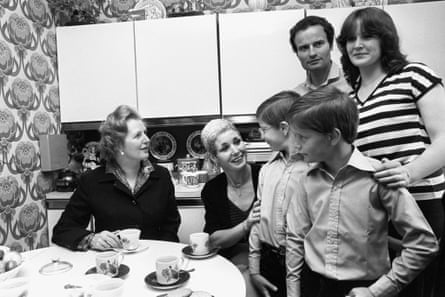 View image in fullscreenMargaret Thatcher with the Pattersons, one of the first wave of families to buy their council house, 1980. Photograph: PA Archive
View image in fullscreenMargaret Thatcher with the Pattersons, one of the first wave of families to buy their council house, 1980. Photograph: PA Archive
The British experience of the last 40 years is not unique. Comparable stories have played out in New York, Tokyo and San Francisco. It also illustrates a more general truth about private property ownership: it carries a great promise that it will make you rich and happy and free, yet over and over that promise is kept at the expense of other people. This truth was realised with brutal force in the enclosures of Britain and the mapping of the continents of North America and Australia with property lines that excluded their native populations. It plays out in contemporary Britain, where some live in tiny flats in converted office blocks, their children playing in car parks, while others have more space than they know what to do with.
The question is, can the promises of property be fulfilled without the exclusion and divisiveness that regularly goes with it, and if so, how? This in turn depends on a matter pondered by famous philosophers over previous centuries, as to what private property is. Is it “natural”, as John Locke said, almost an extension of the human body, a limb by other means? Or is it a fiction, a contrivance, a useful instrument? And is it ever purely private? Or is the wealth of property, as the 19th-century American political economist Henry George said, primarily social, created not only by an individual owner, but also by the efforts of those around her or him, who might create the business and provide the transport and bring the people that contribute to the value of a plot?
Grace is a university graduate, London-born, in her mid-thirties. She and her husband Cody have two children. Her grandmother Rose enjoyed a secure tenancy in public housing for 40 years. Her parents Kathy and Eddie benefited from Thatcher’s right-to-buy policy and four decades of house price inflation. They too were tenants of a local authority, but were able to buy their home in the 1980s. In due course they sold it and bought a larger home in a cheaper area, which is now worth several times what they paid for it.
But where her parents and grandmother had lived securely in homes that met their needs, whether as renters or owners, Grace and her family have struggled to do the same. Collectively, the three generations have experienced the vicissitudes of private and public property ownership, with contrasting effects on the quality of their lives. They happen to have lived through 60 years of shifts and switches, from a time when state-funded public housing was ascendant, to the rise of private ownership, to the present of high prices and diminished public sector alternatives.
Grace at various times lived with her parents and in privately rented accommodation with Cody. Eventually they found a place that suited them. They decorated it, improved it and transformed its garden. “Because we had grown up in a house that was our house, I never felt insecure,” she says, so she was happy to put time and money into making it better. But then they got a “bombshell letter” from their landlord, announcing that he was selling the property and that they would have to move out.
By now the “hard moment of truth” had dawned on Grace and Cody that “actually home ownership is really difficult and really unlikely to happen”. They moved back into two rooms at Grace’s parents’ house – ‘a really stressful time … things started falling apart”. They considered an option whereby they could part-own and part-rent a home, which turned out to be a “really terrible deal”. Eventually they found temporary accommodation on a large public housing project that was in the process of being demolished and redeveloped. “There were gangs and drugs. The bottom of our communal staircase was effectively a 24-four-hour pharmacy – if I’d ever wanted to take crack or heroin, all I’d have had to do was go down there and look like I wanted something.”
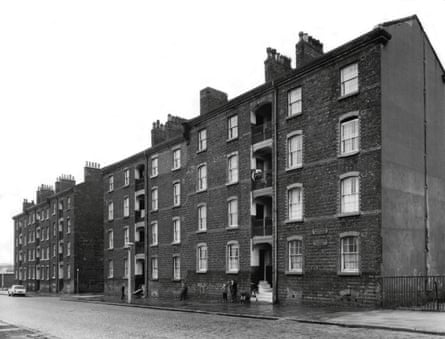 View image in fullscreenSt Martin’s Cottages, Liverpool, the first council flats, built in 1869 and demolished in 1977. Photograph: Smith Archive/Alamy
View image in fullscreenSt Martin’s Cottages, Liverpool, the first council flats, built in 1869 and demolished in 1977. Photograph: Smith Archive/Alamy
After that there was a period when they rented from friends, from where they and their children went to a privately rented two-bedroom flat above an all-hours kebab shop on a noisy road. Grace and Cody were both in full-time employment, but they still needed state benefit to help pay the rent, to do which they claimed that Grace was a single mother, and Cody absent. They committed benefit fraud, in other words, without which they would have had to live somewhere worse.
They believe they were not unusual: “There are so many people doing that, and necessarily so. People not doing it are extra fucked over – if everyone is robbing and you’re not robbing, you’re extra worse off.” But as well as being a crime, their deception took its toll. “You’re always looking over your shoulder,’ says Cody. ‘You have to make sure the kids don’t say ‘Daddy’ when you’re on the phone.”
The contrast between Grace’s experiences of property and those of her parents and grandparents is striking. Rose, who worked as a waitress, never had much money – she owned £700 when she died – and her home was modest. But it gave her everything she needed and wanted and she had no fear of losing it. She was supported by a welfare state that would take care of her health and basic wellbeing. She therefore had the freedom and resources to support others, to help look after her grandchildren, to build friendships with her neighbours, to contribute to her community. She felt no need to hoard capital as a defence against the future. Kathy and Eddie, as a result of right to buy, found similar freedoms by a different route.
Rose, who had almost no capital, and Kathy and Eddie, who came to possess quite a lot, all felt both safe and in charge of their own destiny. For Grace and Cody, renting from private landlords, this was not the case. “You’re in a market,” Grace says. “Your tenancy is a product. You’re competing to be the least annoying tenant, the one best able to look after the flat – which also means the least vulnerable.”
The state, as it does for example in Singapore, could be a provider of homes of various tenures and prices
They have now moved to another country and hope to buy there. “People like me”, she says, “so want to own their home, to get that one golden ticket”, but she’d prefer a world in which there were other ways to live well. In all of her family’s housing adventures, she says that the happiest time was on the social housing estate condemned for demolition. There was, she says, “a sense of community – possibly a community of misfits and deplorables, but there was some kind of warmth, a consciousness of a shared experience”. It helped that they paid a low rent, that they were not spending most of their income on housing costs. It also helped that, as tenants of a local authority, “we never felt pressure from a private landlord; we were at liberty to put pressure on them – that sense of agency adds to our sense of wellbeing”. But this relative contentment was only available in a place that wouldn’t be there for long.
Theirs is not an exceptional story, but it is a vivid microcosm of the experiences of millions. People of all ages face the prospect of living their whole lives in insecure accommodation, all with negative effects on wellbeing, family life and the economic success of the country – also, according to the Adam Smith Institute, on fertility. A new and widening class divide has been created, generational, social and regional, between the property haves and have-nots. The property ladder has become for many a construction as unreal as a magic beanstalk; the pretty stories of home making told in movies and the media and advertising are now a cruel joke.
There are other ways than private ownership and owner-occupation of achieving shelter and community and inhabiting land. Take modern Vienna, which owes much to the desperation and enterprise of the “wild settlers” who, driven by the economic collapse that followed Austria’s defeat in the first world war, occupied land on the city’s outskirts. These groups of what were essentially squatters started a process that, a century later, still shapes the city’s social and physical fabric.
By 1921, 30,000 families, unable to find or afford homes, and feeding themselves only with difficulty, had moved into sheds and cabins on what were originally allotments, created to help feed the city during the war. They farmed and gardened. They built new structures and adapted what they found. They set up cooperative forms of self-government. Austria’s Social Democratic party, at first suspicious of the settlers’ entrepreneurship, came to support them. Later in the 1920s, in control of Vienna and with a tax base to support them, the party addressed housing need on a much greater scale, with “superblocks” of a thousand homes or more. These were in some ways the opposite of the informal settlements – they were in the city rather than outside; they were large, planned and often monumental in their architecture. They can indeed be seen as a way of taming the dangerously anarchic spirit of the settlements, but they continued from the latter the spirit of community. Central to their concept were shared courtyard gardens, laundries, libraries, cinemas, kindergartens and theatres.
The most famous of these developments, the kilometre-long Karl Marx Hof, celebrates the people it houses with a series of triumphal arches. Red-painted expressionist compositions of towers and balconies, each bearing a flagpole, march like robots across the elevations. When civil war broke out in 1934 it became a citadel for socialists against the fascists who would eventually win the conflict, its balconies used as gun emplacements. It is still there now, its gardens and shared facilities generating an atmosphere of communal peacefulness that is at odds with its violent history.
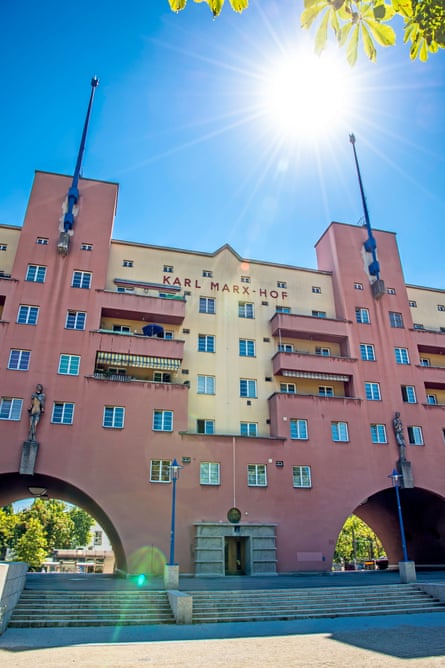 View image in fullscreenKarl Marx Hof, Vienna. Photograph: Wolfgang Zwanzger/Alamy
View image in fullscreenKarl Marx Hof, Vienna. Photograph: Wolfgang Zwanzger/Alamy
What also survived, despite the intervention of Nazi rule and world war, was the principle that municipal government should support such housing. In the 1990s, when Britain and other countries were selling off their social housing, Vienna continued to build it. Sixty per cent of the city’s population now lives in homes built and run by the city, or by not-for-profit cooperatives that it helps to support. It makes for a metropolis where people of different incomes can share the same neighbourhoods, and where homes are close to places of work and leisure. As other cities become zoned and polarised these are prized qualities. Vienna would not have them without the chain of events that the wild settlers started.
Britain, through the writings of Locke, through law and policy, through enclosure and colonisation, did much to establish the modern idea of private home ownership. It has also played a leading role in creating a once-radical alternative, social housing in various ways supported or created by the state, that is now to be found across the world. From the first council flats, built in Liverpool in 1869, to the postwar building of mass housing and new towns, this programme has, as the social historian John Boughton puts it, “improved the lives of many millions of our citizens”.
Public housing was, for a while, a cause that transcended party divisions. “Housing is not a question of Conservatism or socialism,” said the Tory housing minister and future prime minister Harold Macmillan in 1951; “it is a question of humanity.” As Lynsey Hanley wrote in Estates: An Intimate History, it manifested a “dream of holding a fair and equitable stake in the collective wealth of the nation – of which good housing formed a part”. Lying behind these programmes, especially the building of new towns, was the principle expressed by Henry George, that wealth in property is social as well as private, a collective as well as an individual creation.
The failings of publicly funded social housing programmes – “sink estates”, “concrete jungles” – are well-documented, but as the different but no less significant failings of private property markets have become so clear, the attractions of public alternatives become stronger. One can hope that the latter might learn from past mistakes, such as the ghettoisation of those in greatest need in monocultural enclaves. The state, as it does for example in Singapore, could be a provider of homes of various tenures and prices. The good news is that the mechanisms for achieving such ends exist, in that social and affordable housing exists and continues to be built. The question is how these tools are put to use.
My name is Rowan Moore and I am a millionaire. That is, I own property assets with a value over £1m sterling. This is not because my work as an architecture critic is fabulously lucrative, or because I am a financial genius, or because I inherited great wealth, but because I have lived in a particular time and place in which the ownership of a home has been a ticket to an unearned and untaxed fortune.
I am lucky. I may have made some decisions I might consider smart, and have made some bets that paid off, and weathered some financial squalls, and worked hard, but most of all I am lucky. There are other people as hardworking as me who do not have so many zeros on their capital – because they are younger, for example, or live in a different city, or for some other reason did not have the opportunity to get on the property escalator at an advantageous time.
So what do I do with my luck? Do I give everything away to others less fortunate? Mostly I do not. I hang on to my assets. I think they might be helpful for my children’s security, and for their own prospects of getting a home in an overpriced market. I’d like to store up some cash to pay for my potential care needs in old age, in the knowledge that in this respect I can’t hope for much help from the state. It seems a little futile unilaterally to renounce my wealth when others like me do not. And, frankly, when you have stuff it’s difficult to give it up.
But I don’t feel that I deserve it all. I know that there are so many others who are struggling to achieve a sliver of what I have. It is impossible for me not to want to help my children, and there are philosophers who argue that impulses like mine are positively moral, but I know that such help perpetuates a property-based division of classes. I would like to be less rich. I would like my home to be worth less. I would welcome house price deflation, so long as prices fell roughly equally, and not disproportionately on my own property. It would also be important that other owners less well placed than me – people who have only recently bought, for example, and can only just afford their mortgage – aren’t collateral damage in any property crash.
I would welcome taxation of my unearned profits, but it would help if I could trust that the taxes raised from me and my like would be well spent, in particular on addressing housing need elsewhere. If I could believe that, whatever happened, I and my children could be sure of a decent place to live and adequate health and social care – as was Grace’s grandmother Rose – I would have less desire to hoard. Until this new arrangement arrives, however, I expect I will act much like other people who own: striving to protect my assets, aiming to get a high price when selling and a low one when buying.
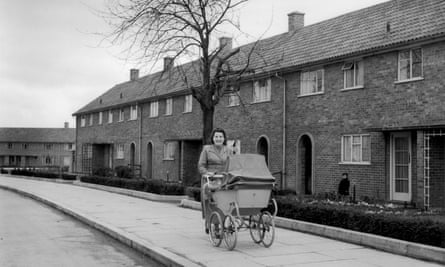 View image in fullscreenCouncil houses in the Adeyfield district of Hemel Hempstead, developed after the second world war as a new town. Photograph: Haywood Magee/Getty Images
View image in fullscreenCouncil houses in the Adeyfield district of Hemel Hempstead, developed after the second world war as a new town. Photograph: Haywood Magee/Getty Images
Such a change in public policy would require a shift in what has been the dominating philosophy of government since the 1980s, that private property is supreme, that – in the tradition going back to Locke – it is “natural”, almost divine. It remains a hugely effective, beneficial and desirable way to hold and manage land, but it is not the only one. Its gifts are prone to disproportion. They reward luck and sometimes force. Property can fortify the proceeds of abuse and entrench divisions between those who have it and those who do not.
Thomas Jefferson said that land should belong ‘in usufruct to the living’, that what matters most is not eternal proprietorship, but the ability to benefit from it during your life. Property is social as well as private. The value of my home is built on public and private investment, and on all the striving of millions who make London a successful city. It is also based on the future prices to be paid – barring a huge crash in values – by younger and newer buyers. If they have to pay much more than I did for the same space, at least part of my fortune is at their expense – given which, society has a case for reclaiming something from me.
Private property is a means to ends – shelter, security, freedom, wealth, happiness. It is often effective and powerful, but it is the ends that matter most. Where property fails to do its job, it has to be challenged, reformed and where necessary augmented with more useful alternatives. The long experiment with a “property owning democracy” has had its successes, but is also showing dangerous cracks. The task now is not to sweep away private property, but to show how its beautiful promises might be fulfilled.
Built for success
Three collective schemes that show a different path
Karl Marx Hof, Vienna
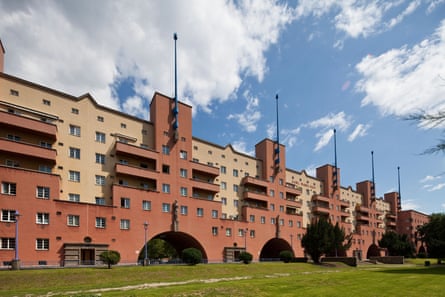 View image in fullscreen Photograph: Alamy
View image in fullscreen Photograph: Alamy
Built in Vienna from 1927 to 1930, this the best known of the major projects built by the Social Democratic Party of Austria in response to the housing crisis that followed the first world war. It is heroic in scale and design, more than 1km long and containing 1,382 apartments, with a celebratory architecture of towers and triumphal arches. It is designed as a community rather than just housing, with shared gardens, libraries, laundries, cinemas and kindergartens. Along with other projects of its time, it set a pattern of publicly funded housing that – despite the upheavals of Austrian history since – survives to the present.
Co-op City, New York
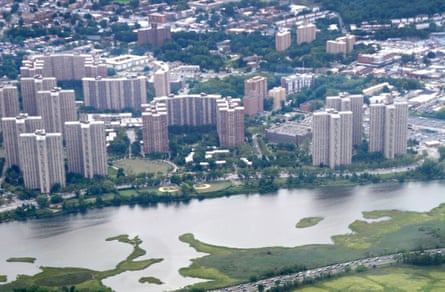 View image in fullscreenCo-op City in the Baychester section of the Bronx, by the Hutchinson river, is the largest cooperative housing development in the world. Photograph: Robert Alexander/Getty Images
View image in fullscreenCo-op City in the Baychester section of the Bronx, by the Hutchinson river, is the largest cooperative housing development in the world. Photograph: Robert Alexander/Getty Images
With 15,000 homes in 35 buildings, this was the largest and most ambitious project of New York’s 20th-century co-operative housing movement. It opened in the Bronx in 1968, offering residents from diverse social and ethnic backgrounds the chance to buy homes at a fraction of market prices, plus a monthly maintenance charge, on condition that any resale is at the same price plus interest. They can also take part in the management of the estate, as a result of which it is better cared-for than similar-looking developments elsewhere. Its history has been fraught, requiring major refinancing, but its residents express high levels of contentment and pride in their community.
Granby Four Streets, Liverpool
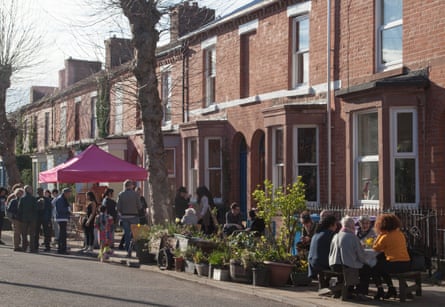 View image in fullscreen Photograph: Assemble
View image in fullscreen Photograph: Assemble
This is a celebrated British example of a community land trust (CLT), a not-for-profit organisation which holds land in perpetuity for the benefit of its residents. Designed by the Turner prize-winning architectural collective Assemble, the project has turned near-derelict Victorian terraces into a delightful and successful neighbourhood with homes at affordable prices. Its shared facilities include a winter garden, a successful market and the transformation of its streets with flowers and plants. Its small size and gradual pace of development, though, suggest CLTs will need a lot of government support if they are to make a major contribution to addressing the housing crisis.
-
Property by Rowan Moore is published by Faber on 2 November (£14.99). To support the Guardian and Observer order your copy at guardianbookshop.com. Delivery charges may apply


